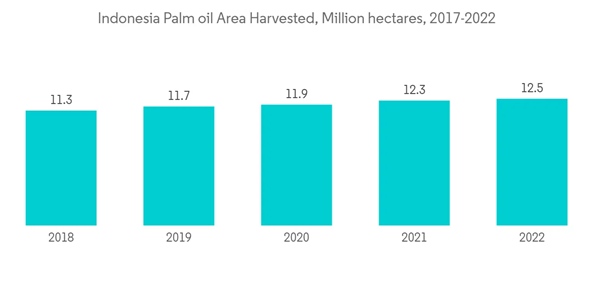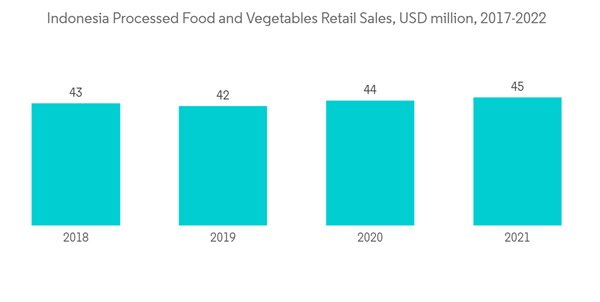The COVID-19 outbreak caused worldwide lockdowns, disruptions in manufacturing activities and supply chains, and production halts, all of which harmed the nitric acid market in 2020. However, after the pandemic, the demand for nitric acid recovered in Indonesia.
Key Highlights
- The growing adoption of nitric acid in fertilizer is driving market growth.
- The use of nitric acid in the chemical industry for manufacturing adipic acid, nitrobenzene, and other chemical manufacturing is also a blooming opportunity for the market studied.
- The adverse effects of nitric acid on human health are hindering market growth.
Indonesia Nitric Acid Market Trends
Fertilizer Segment to Dominate the Market
- Nitric acid produces ammonia nitrate, which is further converted into urea ammonium nitrate (UAN) by a particular reaction. Urea ammonium nitrate (UAN) is used as fertilizer, creating a massive demand for nitric acid within the fertilizer industry.
- In Indonesia, urea fertilizer is most produced, followed by triple superphosphate (TSP), ammonium sulfate, and KCI (potassium chloride). Urea fertilizers are most used in Indonesia for food crops, estate (perennial), and horticulture crops. There is a high demand for urea fertilizer within the country, which is met by various exporting countries such as the Philippines, Singapore, India, Japan, and Vietnam, increasing the demand for nitric acid to produce urea fertilizer within the country.
- Ammonium nitrate is a popular and effective nitrogen-based fertilizer that contains around 35% (by mass) of total nitrogen. Furthermore, calcium ammonium nitrate (CAN) fertilizer includes 25-28% nitrogen. CAN fertilizer is used to deliver nitrogen to plants to help them thrive.
- Over half of the world's palm oil is produced in Indonesia, the top producer. The nation exports more than two-thirds of the world's palm oil, making it the largest palm oil exporter in the world. Including refined bleached and deodorized (RBD), crude palm oil (CPO), and palm kernel oil, Indonesia produces and exports a wide range of palm oil-related goods.
- Palm oil trees need a balanced fertilizers strategy to achieve optimum growth and production. According to USDA Foreign Agriculture Service data, Indonesia rapidly expanded its palm oil harvestable area in recent years. In 2022, 12.5 million hectares of palm oil were harvested in Indonesia.
- Therefore, considering the factors mentioned above, the demand for the nitric acid market is expected to rise in the fertilizer industry significantly shortly.
Growth in the Food Industry
- Nitric acid is used for potassium nitrate production, an additive and coloring agent for salted meat during the manufacturing process of preserved foods. In food safety, nitric acid is used to identify the toxic chemical presence chemicals in food products.
- Rise in per-capita income and an increase in middle-class population, Indonesia is the largest economy in Southeast Asia.
- Currently, Indonesia’s food market amounts to USD 289.30 billion. The market is expected to grow by over 6% over the next eight years.
- All factors above are likely to fuel the growth of the nitric acid market in Indonesia over the forecast time frame.
Indonesia Nitric Acid Market Competitor Analysis
The nitric acid market in Indonesia is fragmented in nature. Some of the major players in the market include BASF SE, MercK KGaA, Mitsubishi Chemical Corporation, Thermo Fisher Scientific Inc., and Perdana Chemindo Perkasa, among others.Additional benefits of purchasing the report:
- The market estimate (ME) sheet in Excel format
- 3 months of analyst support
This product will be delivered within 2 business days.
Table of Contents
1 INTRODUCTION1.1 Study Assumptions
1.2 Scope of the Study
2 RESEARCH METHODOLOGY
3 EXECUTIVE SUMMARY
4 MARKET DYNAMICS
4.1 Drivers
4.1.1 Increasing Demand from the Fertilizer Industry
4.1.2 Growth in the Food Industry
4.2 Restraints
4.2.1 Adverse Effects of Nitric Acid on Human Health
4.2.2 Other Restraints
4.3 Industry Value-Chain Analysis
4.4 Porter's Five Forces Analysis
4.4.1 Bargaining Power of Suppliers
4.4.2 Bargaining Power of Consumers
4.4.3 Threat of New Entrants
4.4.4 Threat of Substitute Products and Services
4.4.5 Degree of Competition
5 MARKET SEGMENTATION (Market Size in Volume)
5.1 End-User Industry
5.1.1 Fertilizers
5.1.2 Inks, Pigments, and Dyes
5.1.3 Chemical Manufacturing
5.1.4 Explosives
5.1.5 Other End-user Industries (Pharmaceuticals, Food Processing, etc.)
6 COMPETITIVE LANDSCAPE
6.1 Mergers and Acquisitions, Joint Ventures, Collaborations, and Agreements
6.2 Market Share (%) ** / Ranking Analysis
6.3 Strategies Adopted by Leading Players
6.4 Company Profiles
6.4.1 BASF SE
6.4.2 Hanwha Corporation
6.4.3 MercK KGaA
6.4.4 Mitsubishi Chemical Corporation
6.4.5 MNK
6.4.6 PT. Perdana Chemindo Perkasa
6.4.7 Thermo Fisher Scientific
6.4.8 Yara
6.5 MARKET OPPORTUNITIES AND FUTURE TRENDS
6.5.1 Technological Developments in Nitric Acid Manufacturing and Recent Government Incentives
Companies Mentioned (Partial List)
A selection of companies mentioned in this report includes, but is not limited to:
- BASF SE
- Hanwha Corporation
- MercK KGaA
- Mitsubishi Chemical Corporation
- MNK
- PT. Perdana Chemindo Perkasa
- Thermo Fisher Scientific
- Yara










